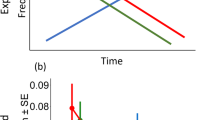Summary
-
1.
The possible impact of arthropod predation on inter-population variation in adult density of a thistle-feeding lady beetle,Henosepilachna niponica (Lewis) was evaluated by means of predator exclusion experiments conducted in the field.
-
2.
The population density of newly-emerged adults at one habitat in the upstream area (site F) was significantly lower than at another in the downstream area (site A) although the egg density was nearly identical in the two habitats.
-
3.
In the habitat with lower adult density, egg mortality was higher due to higher levels of predation. A predator exclusion experiment demonstrated that arthropod predation was the main factor causing high mortality during the immature stages, and physical factors such as heavy rains were unlikely to influence larval survivals.
-
4.
Earwigs, ground beetles, predaceous stink bugs, and spiders were identified as the main predators in the study area. Of these, an earwig,Anechura harmandi (Burr) was more predominant than other predators and was significantly more abundant in the habitat with low adult densities.
Similar content being viewed by others
References
DeBach, P., D. Rosen andC. E. Kennett (1971) Biological control of coccids by introduced natural enemies. 165–194. InC. B. Huffaker (ed)Biological control. Plenum, New York.
DeBach, P. (1974)Biological control by natural enemies. Cambridge Univ. Press.
Dempster, J. P. (1969) The control ofPieris rapae with DDT. II. Survival of the young stages ofPieris after spraying.J. Appl. Ecol. 5: 451–462.
Dempster, J. P. (1971) The population ecology of the cinnabar moth,Tyria jacobaeae L. (Lepidoptera, Arctiidae).Oecologia 7: 26–67.
Dempster, J. P. andT. H. Coaker (1974) Diversification of crop ecosystems as a means of controlling pests. 106–114. InD. P. Jones andM. E. Solomon (eds)Biology in pest and disease control. The 13th Symposium of the British Ecological Society. Blackwell Scientific Publications, Oxford.
Ehler, L. E. andR. van den Bosch (1974) An analysis of the natural biological control ofTrichoplusia ni (Lepidoptera: Noctuidae) on cotton in California.Can. Entomol. 106: 1067–1073.
Eickwort, K. R. (1977) Population dynamics of a relatively rare species of milkweed beetle (Labidomera).Ecology 58: 527–538.
Gilbert, N. (1980) Comparative dynamics of a single-host aphid. I. The evidence.J. Anim. Ecol. 49: 351–369.
Katakura, H. (1981) Classification and evolution of the phytophagous ladybirds belonging toHenosepilachna vigintioctomaculata complex (Coleoptera, Coccinellidae).J. Fac. Sci., Hokkaido Univ., (VI-Zool.) 22: 301–378.
MacPhee, A. W. andC. R. MacLellan (1971) Cases of naturally-occurring biological control in Canada. 312–330. InC. B. Huffaker (ed)Biological Control. Plenum, New York.
McClure, M. S. (1977) Resurgence of the scale,Fiorinia externa (Homoptera: Diaspididae), on hemlock following insecticide application.Environ. Entomol. 6: 480–484.
Nakamura, K. andT. Ohgushi (1979) Studies on the population dynamics of a thistle-feeding lady beetle,Henosepilachna pustulosa (Kôno) in a cool temperate climax forest. I. The estimation of adult population parameters by the marking, release and recapture method.Res. Popul. Ecol. 20: 297–314.
Nakamura, K. andT. Ohgushi (1981) Studies on the population dynamics of a thistle-feeding lady beetle,Henosepilachna pustulosa (Kôno) in a cool temperate climax forest. II. Life tables, key-factor analysis, and detection of regulatory mechanisms.Res. Popul. Ecol. 23: 210–231.
Ohgushi, T. (1983) Population processes and life history strategy of an herbivorous lady beetle,Henosepilachna niponica (Lewis). Ph. D. thesis, Kyoto University (In Japanese).
Ohgushi, T. andH. Sawada (1981) The dynamics of natural populations of a phytophagous lady beetle,Henosepilachna pustulosa (Kôno) under different habitat conditions. I. Comparison of adult population parameters among local populations in relation to habitat stability.Res. Popul. Ecol. 23: 94–115.
Ohgushi, T. andH. Sawada (1984) Inter-population variation of life history characteristics and its significance on survival process of an herbivorous lady beetle,Henosepilachna niponica (Lewis) (Coleoptera, Coccinellidae).Kontyu 52: 399–406.
Ohgushi, T. andH. Sawada (1985) Population equilibrium with respect to available food resource and its behavioural basis in an herbirorous lady beetle,Henosepilachna niponica.J. Anim. Ecol. 54: 781–796.
Pollard, E. (1971) Hedges. VI. Habitat diversity and crop pests: a study ofBrevicoryne brassicae and its syrphid predators.J. Appl. Ecol. 8: 751–780.
Randall, M. G. M. (1982) The dynamics of an insect population throughout its altitudinal distribution:Coleophora alticolella (Lepidoptera) in northern England.J. Anim. Ecol. 51: 993–1016.
Sawada, H. (1984) The dynamics of an artificially introduced population of an herbivorous lady beetle,Henosepilachna niponica (Lewis). Ph. D. thesis, Kyoto University (In Japanese).
Smith, J. G. (1976) Influence of crop background on natural enemies of aphids on Brussels sprouts.Ann. Appl. Biol. 83: 15–29.
Whittaker, J. B. (1971) Population changes inNeophilaenus lineatus L. (Homoptera: Cerocopidae) in different parts of its range.J. Anim. Ecol. 40: 425–443.
Author information
Authors and Affiliations
Additional information
Recently,Katakura (1981) reclassifiedHenosepilachna pustulosa (Kôno) into three distinct species and some unsettled populations. In this paper, the species name follows his classification.
Rights and permissions
About this article
Cite this article
Ohgushi, T., Sawada, H. Arthropod predation limits the population density of an herbivorous lady beetle,Henosepilachna niponica (Lewis). Res Popul Ecol 27, 351–359 (1985). https://doi.org/10.1007/BF02515472
Issue Date:
DOI: https://doi.org/10.1007/BF02515472




